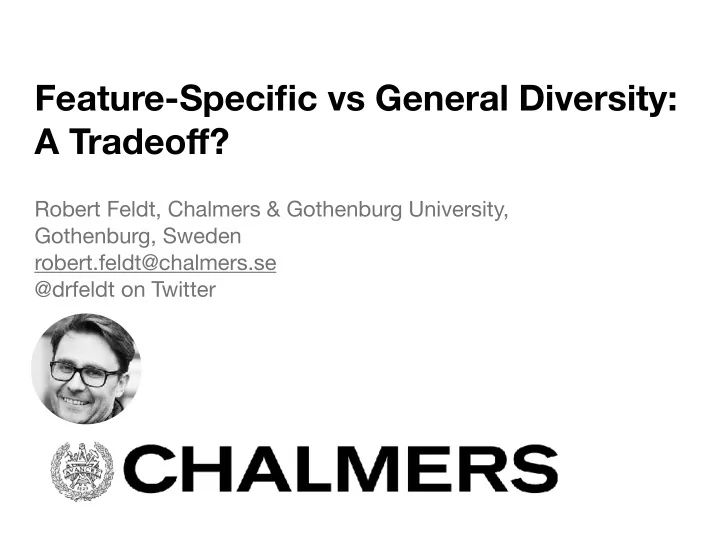

Feature-Specific vs General Diversity: A Tradeo ff ? Robert Feldt, Chalmers & Gothenburg University, Gothenburg, Sweden robert.feldt@chalmers.se @drfeldt on Twitter
Main message: There is a trade-o ff between two types of DIVERSITY Domain-specific NID, NCD Feature-specific General, even Universal Specific, problem adapted Analysable (theory, math) Hard to analyse, no theorems Simple & Cheap (to Human) ~Costly (to Human) Costly (to CPU) Cheap (to CPU) Needs more information Lean, directly applicable
Testing still (mainly) based on intuition & heuristics “To better cover system behaviour, run di ff erent test cases” “Don’t put all your eggs in one basket”, spread the risk To formalise, analyse, automate etc we need to quantify ! NCD and it’s extensions (NCDm) allows us to do this!
Information distance Roughly speaking, two objects are deemed close if we can significantly “compress” one given the information in the other, the idea being that if two pieces are more similar, then we can more succinctly describe one given the other.
Already at ICST 2008 in Lillehammer… where C(s) is length of string s after being compressed with your favourite compressor (zlib, bzip2, ppm, blosc, lz4, zstandard, …)
NCD in 5 lines of Julia code NCDm would be another ~15 lines to do the looping!
NCDm extension is very useful in testing! d( , ) = num ?? Test Set Diameter (TSDm): - Works for any test information / data type - Inputs, Outputs, State, Traces… - Measures distance of a whole multiset , not just pairs - Empirical results shows that test sets selected by it - increases code and fault coverage
RQ2: Higher code coverage if select based on Input-TSDm? 9.8x 2.5x
A simple expression generator (for testing calculators) @generator ExprGen begin start() = expression() expression() = operand() * operator() * operand() operand() = "(" * expression() * ")" operand() = (choose(Bool) ? "-" : "") * join(plus(digit)) digit() = choose(Int,0,9) operator() = "+" operator() = "-" operator() = "/" operator() = "*" end
Hillclimb (search) NMCS (search) Random-once Rand
Length vs Num digits
Length vs Num digits
Length vs Num digits
Length vs Num digits
Length vs Num digits
Length vs Num digits
Length vs Num digits
Length vs Num digits
Length vs Num digits
Length vs Num digits
Length vs Num digits
Main message: There is a trade-o ff between two types of DIVERSITY Domain-specific NID, NCD Feature-specific General, even Universal Specific, problem adapted Risk being Analysable (theory, math) Hard to analyse, no theorems unfocused Simple & Cheap (to Human) ~Costly (to Human) Costly (to CPU) Cheap (to CPU) Risk hiding Risk of missing some features important features Needs more information Lean, directly applicable
robert.feldt@chalmers.se
TSDm is already being applied by others :)
RQ4: Higher fault coverage if select based on Input-TSDm? Test sets on average 45% smaller to reach 95% normalised fault coverage
Word of caution! Length of test case most important!
Kolmogorov wanted a measure for single objects “Actually, it is most fruitful to discuss the quantity of information ‘conveyed by an object’ x ‘about another object’ y.” Kolmogorov complexity of object x = K(x) = length of shortest program to generate x (given no input)
The “Compression trick” Kolmogorov complexity is extremely powerful in theory but cannot be calculated in practice. Enter Cilibrasi and Vitanyi with the Compression trick : Assuming a good, general compressor, c, with no “bias”, we can approximate K(x) with C(x) = length(c(x)). We can apply this trick to a large number of theoretical results and formulas and get methods that often works surprisingly well in practice.
Many sources of test case information VAriability of Tests (VAT) Model of test information sources/types
Test Set Diameter : Quantifying the Diversity of Sets of Test Cases Robert Feldt, Simon Poulding, David Clark, and Shin Yoo
TSDm = NCDm(subset of VAT info) Empirical study here: Input-TSDm Input-TSDm Trace-TSDm Output-TSDm
Empirical study on Input-TSDm SUT Input Size (LOC) Language Measure JEuclid MathML (XML) 11,556 Java Instruction Cov ROME RSS/Atom (XML) 11,704 Java Instruction Cov NanoXML XML 1,630 Java Instruction Cov Replace 2 strings & 1 Regex 538 C Fault cov (seeded)
Conclusions of the TSDm study - We proposed & evaluated Test Set Diameter - General & Universal Measure for Diversity of Test Sets - Works for any type of data and information source - Family of diversity metrics - Easy to implement but fairly slow - Evaluated TSDm on sets of test inputs - One of the more ambitious tasks in testing - Reduces test set size 2x to 10x compared to random - Useful & important concept for SW Quality in general: - Not only for automated test creation - Also analyse manual test suites & tester behaviour
Conclusions - Information theory can provide - theoretically justified metrics for (automated) testing, - practically useful (since universal) metrics that work for any data type, - new ways to formalise & understand testing problems. - Coupling these metrics with search is powerful! - It has helped us formalise, automate, and evaluate: - Value of diversity in testing, - Robustness testing, - (soon in report) Boundary Value testing. - Focusing on available information also has added value in industry collaborations.
Searching for (Test) Diversity Robert Feldt, Simon Poulding
https://arxiv.org/abs/1709.06017
Recommend
More recommend